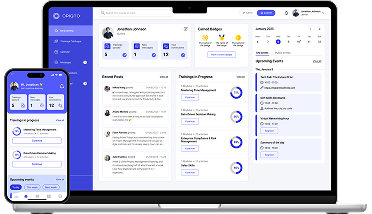
You’ve identified your learning outcomes, drafted your modules, and uploaded your new online courses into your learning management system. But you can tell by the metrics in your LMS dashboard that the course isn’t performing as well as you want it to.
How can you get more students to engage with, complete, and retain the important material you’ve presented in the course content?
Whether in higher education or for the learning and development department, these three tips can help instructors create more effective and engaging online learning.
1. Add multimedia elements
Every learner engages better with different types of course material. Some are visual learners, some do better listening to lectures, and others learn best by reading. That’s why adding different multimedia elements can increase student engagement and help students learn the material more thoroughly.
Along with text-based course content, try recording a series of short video lectures. Use images — or even gifs — to elevate the learning experience in the online classroom. If that sounds daunting, remember that you don’t need to create everything yourself. There are many open educational resources (OER) that you can link to, or even include in your online classes.
Refreshing the multimedia elements in an older online course is a fantastic way to keep training modules current, as well.
2. Encourage social learning
Many online courses can feel isolating for students, especially if they’re used to a face to face class. Implementing social learning techniques can make a huge difference in the student learning experience, and improve learner engagement and the personal connection students have with the course.
Social learning is when students learn from their peers, rather than from an instructor. This is very common informally — think about asking a coworker how to operate the printer, or for a quick tutorial using a software program.
You can encourage social learning in the online classroom by adding a messaging app or discussion boards to your online course through the learning management system.
Struggling students especially can benefit by being able to check in with fellow students, ask questions, and discuss complicated problems as a group. Social online learning also benefits students who have already mastered the material, because it gives them an opportunity to share their knowledge with others and cement it even further.
Social learning would not be complete without a social newsfeed. Similar to the social newsfeed on Facebook or Linkedin where peers can engage with each other, share courses, exchange learning, and share their awards.
3. Make it interactive
Finally, help online students learn more effectively by making your online course as interactive as possible. For example:
- Reward students for learning by gamifying the course material with training badges that students earn upon completing a course.
- Use interactive microlearning to supplement the main course material, and engage students in their spare moments.
- Create digital flashcards that have an illustration or question on one side, and then “flip” to explanatory text when students click them.
- You can also use online quizzes and puzzle games to help improve students’ critical thinking.
Interactivity can be very effective for improving learning outcomes, because it helps keep student attention in a way that a simple lecture can’t.
It’s easy to use these three tips to elevate your online courses when you use a modern learning management system to manage your course content. See a demo of how Opigno LMS can help you create stellar online training today.
Author: Adam Kennedy-Ripon
Design: Simon Contreras
